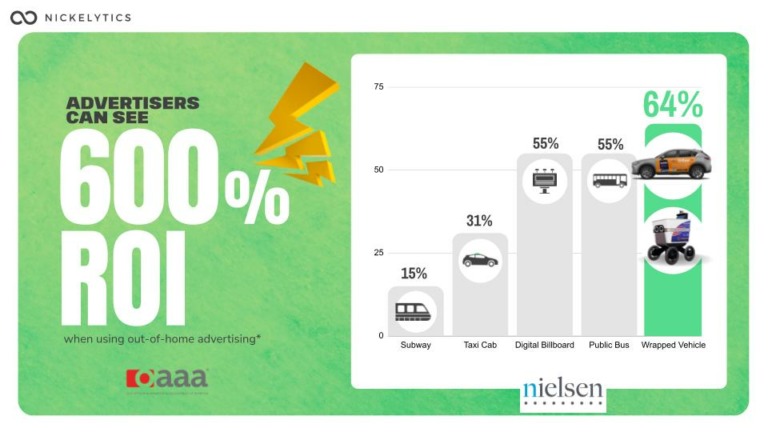O-D study has long been a staple of transportation planning used by urban planners and transportation experts, helping cities and governments understand how people move and commute within their jurisdictions.
But, its applications in the marketing world are only beginning to be fully realized.
What determines the effectiveness of an out-of-home (OOH) ad campaign is its target audience engagement and the conversion rate, and an origin-destination (O-D) study provides a clear path to success by analyzing patterns of movement and behavior.
This research method provides marketers with insights into travel patterns, demographics, and key locations where consumers spend time during a particular day or week, therefore defeating the challenge of knowing where to place ads for maximum impact.
In this article, we shall explore the meaning of origin-destination (O-D) study and how to use it for effective ad placement in OOH advertising.
What is Origin-Destination (O-D) Study?
Origin-destination (O-D) study is a research method used to know the number of vehicles and people moving from one location to another.
Transportation agencies and governments use the O-D study to get accurate numbers of vehicles within a location. They can also understand how transportation policies are implemented.
For example, after enacting New York City’s Commuter Benefits Law in 2016, the New York City Department of Transportation (NYCDOT) conducted an O-D study to understand commuting patterns before and after the law’s implementation.
Similarly, Google’s Aggregated and Anonymized Trips (AAT) have been used to conduct an O-D study to track the movements of a sample of consumers served online ads for a major national retailer.
Having explained the meaning and use cases of an origin-destination (O-D) study, advertisers can use this research method to understand their target audience and tailor their campaigns. We will examine the benefits of conducting an O-D study for your OOH ad campaign.
Benefits of an origin-destination (O-D) study in OOH advertising
Using origin-destination (O-D) studies in marketing can help advertisers target their ads to increase brand engagement and visibility. Here are the benefits of O-D study in your OOH ad placement:
Identifying places with high traffic
An O-D study makes identifying high-traffic areas where the target audience will most likely see the ads easier. An example is how Westfield shopping centers use Wi-Fi technology to track where shoppers go and what shops they visit through their phones.
The study found that the busiest times in the mall were during weekends and holidays and that certain areas were more heavily trafficked than others.
Optimizing locations for ad placement
Applying O-D studies to your OOH campaign can help you understand the flow of people in a given area, which can be used to optimize ad placement.
For example, if an O-D study shows that people tend to move in a particular direction during certain times of the day, marketers can place their ads in a way that captures the most views.

Furthermore, applying O-D studies to your OOH ad campaigns will help you get real-time data to help you place your ads where they will positively impact your target audience. A practical O-D study may require advanced technological tools. The steps will be discussed below.
Steps for Conducting an Effective O-D Study
An effective O-D study is accurate and applicable to the research location. We will look at the steps for conducting an O-D study and how to use them for effective OOH ad placements.
- Defining the study objectives and Scope
Before conducting an O-D study, you must have a scope and objectives for the research. This will limit your study to a variable you can easily work with.
For example, your objective might be to evaluate the feasibility of a new transportation project connecting two cities. Your scope will be to examine the flow of people and goods between the two cities and identify the most commonly used mode of transportation.
- Developing a data collection plan and selecting appropriate tools
You can use some technological tools to plan how to collect your data. With tools like GPS tracking, camera technology, and the Traffic Audit Bureau (TAB) Out-of-Home Ratings app, you can map out the metrics for your data collection.
You can get Geopath measurements to understand consumers’ journeys and exposure to OOH in the physical world by observing and analyzing mobile location data from smartphone applications and connected cars.
Also, you can collect data through Wi-Fi signals emitted by mobile devices and analyze the data to identify patterns in the movement of people.
- Using statistical techniques for data collection and analysis
Utilizing statistical techniques like network analysis and spatial modeling to collect and analyze data in an O-D study can be a valuable tool. Network analysis can be used to study the relationships between entities including transportation networks and social networks.
Spatial modeling, on the other hand, can be used to study and simulate spatial objects in the real world. These techniques will be used to group respondents based on their travel behavior and identify common travel patterns.
- Ensuring data accuracy and reliability through validation and triangulation
Validation and triangulation can accurately predict the data collected at a specific location. Triangulation involves using multiple analysis methods, such as different types of mathematical models, to verify the accuracy and reliability of the findings. Validation helps identify any discrepancies or errors in the model, which can then be corrected.
There are challenges to conducting an O-D study, and it is necessary to understand and overcome them. We will briefly discuss how to overcome the challenges below.
Overcoming Challenges in O-D Study
Conducting an O-D study can be challenging due to several factors, such as data collection and analysis, privacy concerns, data quality, and sample size. To solve the problem of data collection, use multiple data collection methods, like surveys and GPS tracking. This will help you obtain a more comprehensive understanding of travel patterns and reduce the risk of errors.

There is a high chance that the data collected can be incorrect, duplicated, or mislabeled. Data cleaning will help in identifying and correcting or removing inaccurate, incomplete, or irrelevant data from a dataset.
Finally, to mitigate the challenges of privacy concerns, you can use anonymization. The goal of anonymization is to make it impossible or very difficult to identify an individual from the data, even if the data is analyzed in combination with other publicly available information.
Future Trends and Opportunities in O-D Study
The integration of new technologies such as artificial intelligence and machine learning will enhance O-D study capabilities. These technologies have the potential to be used to analyze vast amounts of data quickly and accurately.
Also, incorporating an O-D study with other data sources, such as social media and location-based services, can provide valuable insights into travel patterns and preferences and enable transportation planners to make more informed decisions about transportation infrastructure improvements.
Finally, the O-D study will help outdoor advertising enhance location-based advertising. Location-based advertising can be more effective than traditional advertising because it reaches consumers when they are in a specific location and is more likely to be receptive to the message.
Conclusion
The use of O-D studies in marketing reflects a shift towards data-driven decision-making and emphasizes collaboration between different fields and industries. O-D studies not only enhance the customer experience but also represent a significant opportunity for successful ad placements and informed decision-making.
At Nickelytics, we understand the importance of data. Our data-driven and cross-channel approach to OOH campaigns allows us to place ads based on the analyzed data for a given location.





